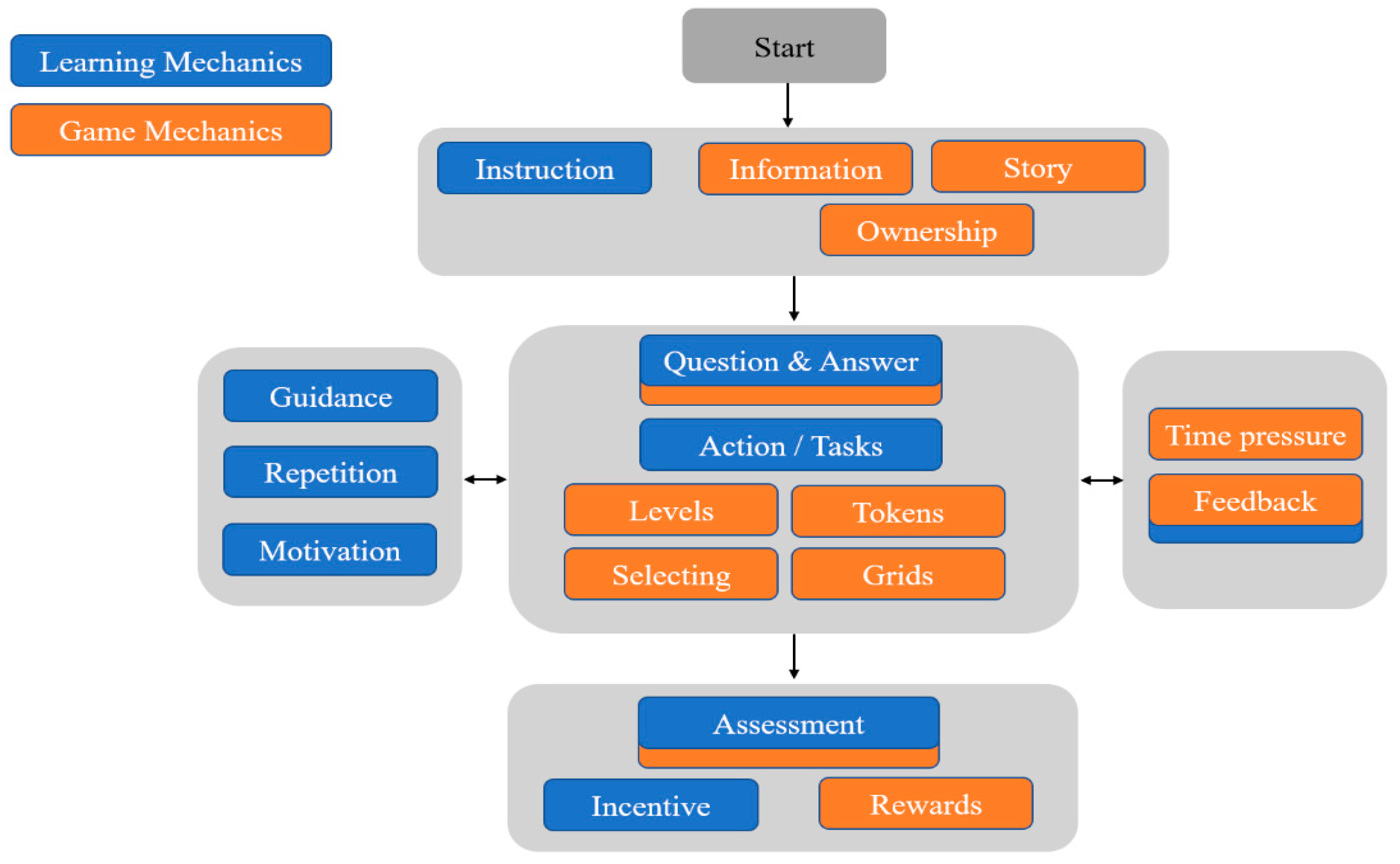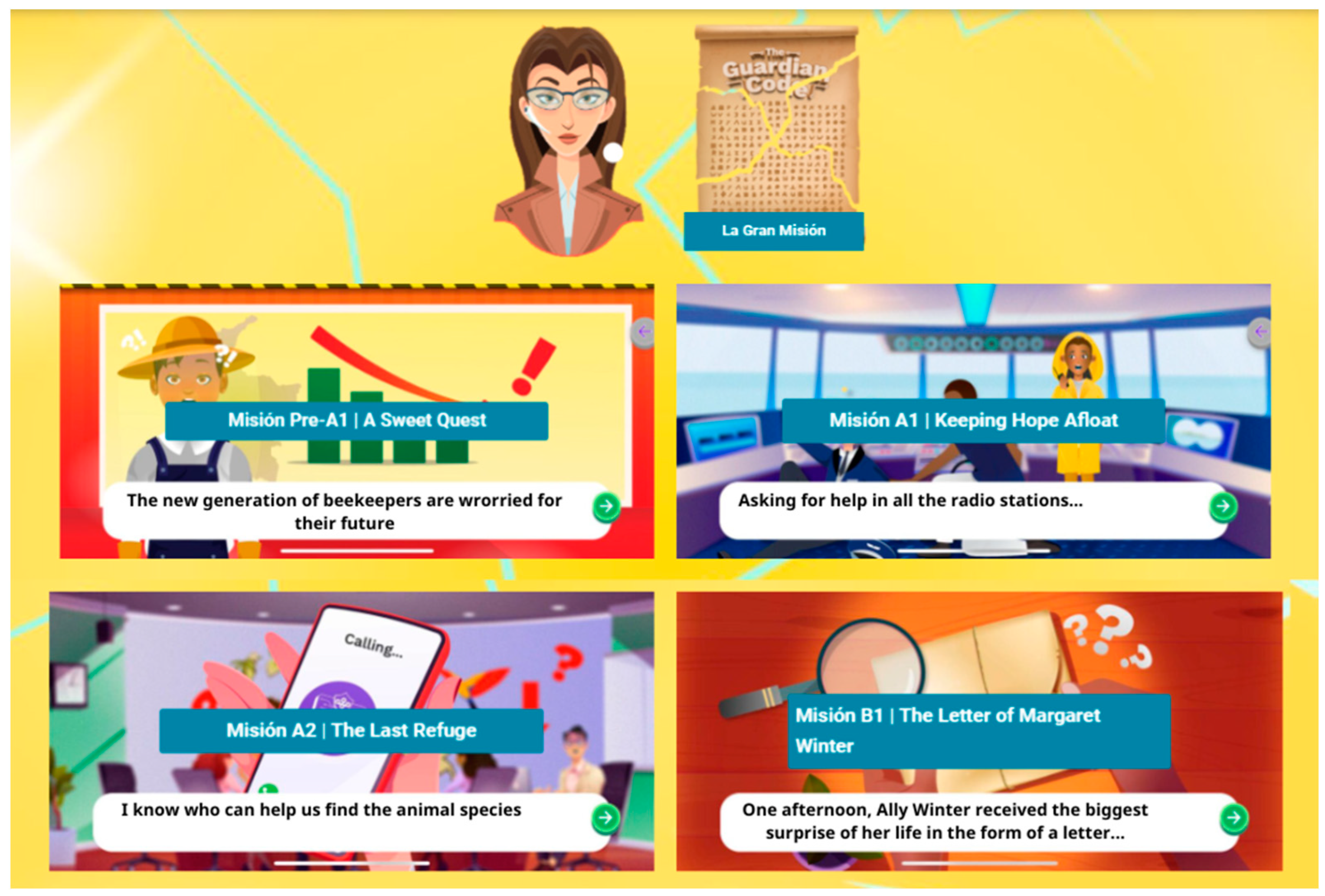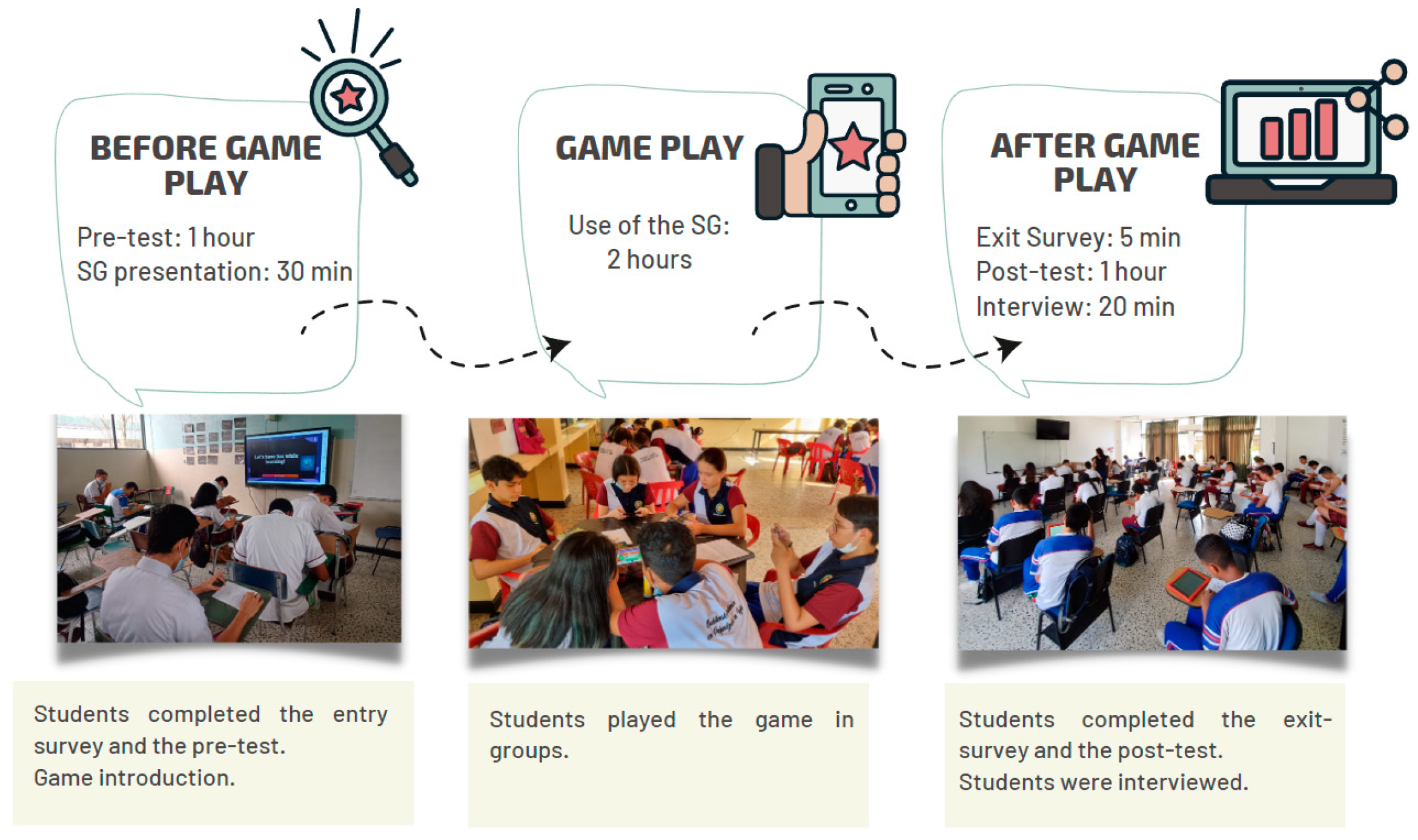Factors Influencing Game-Based Learning in the Colombian Context: A Mixed Methods Study
Abstract
1. Introduction
- What are students’ learning outcomes and experiences in the GBL intervention?
- What are the possible factors that influence the outcomes of students’ GBL, and how do these factors exert their influence?
2. Literature Review
2.1. GBL: Definition and Key Characteristics
2.2. Learning Engagement in Serious Games
2.3. GBL in Language Teaching: Benefits and Limitations
2.4. Influencing Factors for GBL
3. GBL Intervention
4. Methodology
4.1. Participants
4.2. Context and Procedure
4.3. Data Collection
4.4. Data Analysis
5. Findings
5.1. Quantitative Findings
5.1.1. Correlational Results
5.1.2. Predictors of Post-Test Scores
5.2. Qualitative Findings
5.2.1. Male and Female Students Differ in Learning Gains in the GBL Processes
5.2.2. Students’ Family Condition Influenced Their Performance in GBL
5.2.3. Prior Knowledge Positively Influences Students’ Performance in GBL
5.2.4. The Effect of Engagement on GBL Performance
6. Discussion
Practical Implications
7. Conclusions
Limitations and Future Research
Author Contributions
Funding
Institutional Review Board Statement
Informed Consent Statement
Data Availability Statement
Acknowledgments
Conflicts of Interest
Appendix A. Learning Engagement Questionnaire
- Part One: Basic information
| Name | Birth sex |
| Age | Grade |
| Living condition (lives with both parents: Y or N) | Economic condition (middle/low, poor condition) |
- Part two: Engagement
- Emotional engagement
- The vocabulary in Bethe1Challenge was very easy to understand.
- I was effective in using Bethe1Challenge since it was engaging.
- The activities and missions presented in Bethe1Challenge facilitated my active participation.
- Bethe1Challenge caught my attention.
- Bethe1Challenge allowed for my learning of relevant vocabulary in English.
- The use of a mobile device to play Bethe1Challenge made me interested.
- Cognitive engagement
- I demonstrated my interest and enthusiasm, as well as the use of positive humor, while using Bethe1Challenge.
- Bethe1Challenge is relevant for engaging students in vocabulary learning.
- Bethe1Challenge enhanced my engagement in learning English.
- I focused on the missions assigned in Bethe1Challenge.
- Behavioral engagement
- I completed all the missions in the game.
- I spent all the necessary time answering the questions in Bethe1Challenge.
- If I could not complete a mission on the first attempt, I kept working on it until I completed it.
- I want to continue using Bethe1Challenge in my learning process.
References
- Prensky, M. Digital Game-Based Learning; Paragon House: Saint Paul, MN, USA, 2007. [Google Scholar]
- Hess, T.; Gunter, G. Serious game-based and nongame-based online courses: Learning experiences and outcomes. Br. J. Educ. Technol. 2013, 44, 372–385. [Google Scholar] [CrossRef]
- Hwang, G.-J.; Fu, Q.-K. Trends in the research design and application of mobile language learning: A review of 2007–2016 publications in selected SSCI journals. Interact. Learn. Environ. 2018, 27, 567–581. [Google Scholar] [CrossRef]
- Mayer, R.E. Computer games in education. Annu. Rev. Psychol. 2019, 70, 531–549. [Google Scholar] [CrossRef] [PubMed]
- Chen, C.-H.; Shih, C.-C.; Law, V. The effects of competition in digital game-based learning (DGBL): A meta-analysis. Educ. Tech. Res. Dev. 2020, 68, 1855–1873. [Google Scholar] [CrossRef]
- Gee, J.P. What Digital Games Have to Teach Us about Learning and Literacy; St. Martin’s Griffin: New York, NY, USA, 2003. [Google Scholar]
- Kahila, J.; Valtonen, T.; Tedre, M.; Mäkitalo, K.; Saarikoski, O. Children’s Experiences on Learning the 21st-Century Skills with Digital Games. Games Cult. 2019, 15, 685–706. [Google Scholar] [CrossRef]
- Hsu, M.; Cheng, M. Immersion experiences and behavioural patterns in game-based learning. Br. J. Educ. Technol. 2021, 52, 1981–1999. [Google Scholar] [CrossRef]
- Ke, F.; Xie, K.; Xie, Y. Game-based learning engagement: A theory- and data-driven exploration. Br. J. Educ. Technol. 2015, 47, 1183–1201. [Google Scholar] [CrossRef]
- Wronowski, M.; Urick, A.; Wilson, A.S.P.; Thompson, W.; Thomas, D.; Wilson, S.; Elizondo, F.J.; Ralston, R. Effect of a serious educational game on academic and affective outcomes for statistics instruction. J. Educ. Comput. Res. 2019, 57, 2053–2084. [Google Scholar] [CrossRef]
- Kazu, İ.Y.; Kuvvetli, M. A triangulation method on the effectiveness of digital game-based language learning for vocabulary acquisition. Educ. Inf. Technol. 2023. [Google Scholar] [CrossRef]
- Chen, M.-H.; Tseng, W.-T.; Hsiao, T.-Y. The effectiveness of digital game-based vocabulary learning: A framework-based view of meta-analysis. Br. J. Educ. Technol. 2016, 49, 69–77. [Google Scholar] [CrossRef]
- Guillén-Nieto, V.; Aleson-Carbonell, M. Serious games and learning effectiveness: The case of It’s a Deal! Comput. Educ. 2012, 58, 435–448. [Google Scholar] [CrossRef]
- Vermeulen, L.; Van Looy, J.; De Grove, F.; Courtois, C. You Are What You Play? A Quantitative Study into Game Design Preferences Across Gender and Their Interaction with Gaming Habits. In Proceedings of the DiGRA 2011 Conference: Think Design Play, Utrecht, The Netherlands, 14–17 September 2011. [Google Scholar]
- Den, L.; Daverpanah, N.; Izadpanah, S. The effect of educational computer games on the academic resilience, academic self-regulation, and academic achievement of EFL students. Front. Psychol. 2023, 13, 947577. [Google Scholar] [CrossRef]
- Conati, C. Probabilistic assessment of user’s emotions in educational games. Appl. Artif. Intell. 2002, 16, 555–575. [Google Scholar] [CrossRef]
- Gamlo, N. The impact of mobile game-based language learning apps on EFL learners’ motivation. Engl. Lang. Teach. 2019, 12, 49–56. [Google Scholar] [CrossRef]
- Rowe, J.; Shores, L.; Mott, B.; Lester, J. Integrating learning, problem solving, and engagement in narrative-centered learning environments. Int. J. Artif. Intell. Educ. 2011, 21, 115–133. [Google Scholar]
- Wu, W.H.; Hsiao, H.C.; Wu, P.L.; Lin, C.H.; Huang, S.H. Investigating the learning-theory foundations of game-based learning: A meta-analysis. J. Comput. Assist. Learn. 2011, 28, 265–279. [Google Scholar] [CrossRef]
- Licorish, S.A.; Owen, H.E.; Daniel, B.; George, J.L. Students’ perception of Kahoot!’s influence on teaching and learning. Res. Pract. Technol. Enhanc. Learn. 2018, 13, 9. [Google Scholar] [CrossRef]
- Clark, D.B.; Nelson, B.C.; Chang, H.-Y.; Martinez-Garza, M.; Slack, K.; D’Angelo, C.M. Exploring Newtonian mechanics in a conceptually-integrated digital game: Comparison of learning and affective outcomes for students in Taiwan and the United States. Comput. Educ. 2011, 57, 2178–2195. [Google Scholar] [CrossRef]
- Yu, Z.; Gao, M.; Wang, L. The effect of educational games on learning outcomes, student motivation, engagement and satisfaction. J. Educ. Comput. Res. 2020, 59, 522–546. [Google Scholar] [CrossRef]
- Fredricks, J.A.; Blumenfeld, P.C.; Paris, A.H. School engagement: Potential of the concept, state of the evidence. Rev. Educ. Res. 2004, 74, 59–109. [Google Scholar] [CrossRef]
- Hiver, P.; Al-Hoorie, A.H.; Vitta, J.P.; Wu, J. Engagement in language learning: A systematic review of 20 years of research methods and definitions. Lang. Teach. Res. 2021. [Google Scholar] [CrossRef]
- Chen, C.-M.; Liu, H.; Huang, H.-B. Effects of a mobile game-based English vocabulary learning app on learners’ perceptions and learning performance: A case study of Taiwanese EFL learners. ReCALL 2019, 31, 170–188. [Google Scholar] [CrossRef]
- Chen, H.-J.H.; Hsu, H.-L. The impact of a serious game on vocabulary and content learning. Comput. Assist. Lang. Learn. 2019, 33, 811–832. [Google Scholar] [CrossRef]
- Chiu, Y.; Kao, C.; Reynolds, B.L. The relative effectiveness of digital game-based learning types in English as a foreign language setting: A meta-analysis. Br. J. Educ. Technol. 2012, 43, E104–E107. [Google Scholar] [CrossRef]
- Tlili, A.; Hattab, S.; Essalmi, F.; Chen, N.-S.; Huang, R.; Kinshuk, R.; Chang, M.; Burgos, D. A smart collaborative educational game with learning analytics to support english vocabulary teaching. Int. J. Interact. Multimed. Artif. Intell. 2021, 6, 215–224. [Google Scholar] [CrossRef]
- Godwin-Jones, R. Games in language learning: Opportunities and challenges. Lang. Learn. Technol. 2014, 18, 9–19. [Google Scholar]
- Iten, N.; Petko, D. Learning with serious games: Is fun playing the game a predictor of learning success? Br. J. Educ. Technol. 2014, 47, 151–163. [Google Scholar] [CrossRef]
- Oxford, R.L. Teaching and Researching Language Learning Strategies: Self-Regulation in Context; Routledge: Oxfordshire, UK, 2017. [Google Scholar]
- Laine, T.H.; Lindberg, R.S.N. Designing engaging games for education: A systematic literature review on game motivators and design principles. IEEE Trans. Learn. Technol. 2020, 13, 804–821. [Google Scholar] [CrossRef]
- Ben-Sadoun, G.; Alvarez, J. Gameplay Bricks Model, a Theoretical Framework to Match Game Mechanics and Cognitive Functions. Games Cult. 2022, 18, 79–101. [Google Scholar] [CrossRef]
- Dicheva, D.; Dichev, C.; Agre, G.; Angelova, G. Gamification in education: A systematic mapping study. J. Educ. Technol. Soc. 2015, 18, 75–88. [Google Scholar]
- Emerson, A.; Cloude, E.B.; Azevedo, R.; Lester, J. Multimodal learning analytics for game-based learning. Br. J. Educ. Technol. 2020, 51, 1505–1526. [Google Scholar] [CrossRef]
- Breien, F.S.; Wasson, B. Narrative categorization in digital game-based learning: Engagement, motivation & learning. Br. J. Educ. Technol. 2020, 52, 91–111. [Google Scholar] [CrossRef]
- Arnab, S.; Lim, T.; Carvalho, M.B.; Bellotti, F.; de Freitas, S.; Louchart, S.; Suttie, N.; Berta, R.; De Gloria, A. Mapping learning and game mechanics for serious games analysis. Br. J. Educ. Technol. 2014, 46, 391–411. [Google Scholar] [CrossRef]
- Haruna, H.; Hu, X.; Chu, S.K.W.; Mellecker, R.R. Initial validation of the MAKE framework: A comprehensive instrument for evaluating the efficacy of game-based learning and gamification in adolescent sexual health literacy. Ann. Glob. Health 2019, 85, 19. [Google Scholar] [CrossRef]
- Creswell, J.W. Educational Research: Planning, Conducting and Evaluating Quantitative and Qualitative Research; Pearson: London, UK, 2012. [Google Scholar]
- Cohen, L.; Manion, L.; Morrison, K. Research Methods in Education; Routledge: Oxfordshire, UK, 2007. [Google Scholar]
- Wilhelm, C. Gender role orientation and gaming behavior revisited: Examining mediated and moderated effects. Inf. Commun. Soc. 2016, 21, 224–240. [Google Scholar] [CrossRef]
- Sundqvist, P.; Wikström, P. Out-of-school digital gameplay and in-school L2 English vocabulary outcomes. System 2015, 51, 65–76. [Google Scholar] [CrossRef]
- Zhonggen, Y. Differences in serious game-aided and traditional English vocabulary acquisition. Comput. Educ. 2018, 127, 214–232. [Google Scholar] [CrossRef]
- Jossan, K.S.; Gauthier, A.; Jenkinson, J. Cultural implications in the acceptability of game-based learning. Comput. Educ. 2021, 174, 104305. [Google Scholar] [CrossRef]
- Ritterfeld, U.; Cody, M.; Vorderer, P. Serious Games: Mechanisms and Effects; Routledge: New York, NY, USA, 2009. [Google Scholar]
- Saleh, N.; Prakash, E.; Manton, R. Measuring student acceptance of game based learning for game and technology education curriculum development. In Proceedings of the 2014 International Conference on Education Technologies and Computers (ICETC), Lodz, Poland, 22–24 September 2014; pp. 79–85. [Google Scholar] [CrossRef]
- Wouters, P.; van Oostendorp, H. Overview of Instructional Techniques to Facilitate Learning and Motivation of Serious Games. In Instructional Techniques to Facilitate Learning and Motivation of Serious Games; Advances in Game-Based Learning; Springer: Cham, Switzerland, 2016; pp. 1–16. [Google Scholar]
- Vygotsky, L.S. Mind in Society: Development of Higher Psychological Processes; Harvard University Press: Cambridge, MA, USA, 1978. [Google Scholar]
- Sweller, J.; Roussel, S.; Tricot, A. Cognitive load theory and instructional design for language learning. In The Cambridge Handbook of Working Memory and Language; Cambridge University Press: Cambridge, UK, 2022; pp. 859–880. [Google Scholar]
- Skinner, E.A.; Pitzer, J.R. Developmental dynamics of student engagement, coping, and everyday resilience. In Handbook of Research on Student Engagement; Springer: Boston, MA, USA, 2012; pp. 21–44. [Google Scholar]
- Kabilan, M.K.; Annamalai, N.; Chuah, K.M. Practices, purposes and challenges in integrating gamification using technology: A mixed-methods study on university academics. Educ. Inf. Technol. 2023. [Google Scholar] [CrossRef]



| Behaviorism | Cognitivism | Humanism | Constructivism | |
|---|---|---|---|---|
| Game rules | Players are aware of what can be done and what cannot be done. | Players need to predict or guess the rules through logical thinking. | Players engage in direct experiences and are encouraged to reflect upon them. | Game rules are constructed through experimentation and reflection. |
| Game play | Each action results in a specific response in the game world. | Learning is promoted through scaffolding, with context-dependent knowledge. | Players can play the games at their own pace and in their own mood, with a learner-centered design. | Players build expertise by developing new strategies and interacting with others. |
| Game narrative | Game narratives provide clear instructions on the learning tasks. | Players actively learn the meanings of settings, events, characters, and tactics by linking the game with previous gaming experiences. | Players learn about the meaning of the game through interactions with peers or avatars. | The player’s perception of the game world is constructed through social dialogue and interaction. |
| Basic Information | Categories (Assigned Value) | Number | Percentage |
|---|---|---|---|
| Gender | Female (0) | 37 | 57.8% |
| Male (1) | 27 | 42.2% | |
| Age | 15 | 23 | 35.9% |
| 16 | 26 | 40.6% | |
| 17 | 11 | 17.2% | |
| 18 | 3 | 4.7% | |
| 19 | 1 | 1.6% | |
| Living with both parents | No (living with one/neither) (0) | 36 | 56.3% |
| Yes (1) | 23 | 43.8% | |
| Economic condition | Poor a (0) | 44 | 68.8% |
| Lower middle-class b (1) | 20 | 31.3% |
| Selective Coding | Axial Coding | Open Coding | Number of Codes |
|---|---|---|---|
| Contextual influence | Engaging versus distracting | Responsibility | 56 |
| Willingness to learn | 48 | ||
| Making an effort | 35 | ||
| Motivation | 31 | ||
| Perceived game difficulty | 30 | ||
| Good game features versus bad game features | Use of games | 38 | |
| Game mechanics | 45 | ||
| School support versus family support | Peer support | 43 | |
| Teacher support | 37 |
| Mean | SD | 1 | 2 | 3 | 4 | 5 | 6 | 7 | 8 | 9 | |
|---|---|---|---|---|---|---|---|---|---|---|---|
| 1 | 1 | 0.214 | −0.14 | 0.038 | 0.291 * | 0.038 | 0.081 | −0.139 | 0.302 * | ||
| 2 | 1 | 0.193 | 0.034 | −0.104 | 0.125 | 0.22 | −0.072 | −0.103 | |||
| 3 | 1 | −0.017 | −0.168 | 0.165 | 0.047 | 0.248 * | −0.148 | ||||
| 4 | 1 | −0.198 | −0.224 | −0.21 | −0.03 | −0.259 * | |||||
| 5 | 9.70 | 6.690 | 1 | 0.191 | 0.21 | 0.269 * | 0.739 ** | ||||
| 6 | 3.927 | 0.537 | 1 | 0.670 ** | 0.556 ** | 0.348 ** | |||||
| 7 | 4.039 | 0.570 | 1 | 0.360 ** | 0.16 | ||||||
| 8 | 4.086 | 0.533 | 1 | 0.402 ** | |||||||
| 9 | 17.58 | 5.324 | 1 |
| Model 1 | |||||
| Factors | B | SE | β | t | VIF |
| Gender | 3.568 | 1.301 | 0.334 | 2.742 ** | 1.088 |
| Age | −0.859 | 0.701 | −0.151 | −1.226 | 1.108 |
| Living with both parents | −0.818 | 1.29 | −0.077 | −0.634 | 1.078 |
| Economic condition | −3.052 | 1.331 | −0.268 | −2.293 * | 1.003 |
| R2 (Adjusted R2) | 0.197 (0.142) | ||||
| ΔR2 | 0.197 | ||||
| ΔF | 3.617 * | ||||
| Model 2 | |||||
| Factors | B | SE | β | t | VIF |
| Gender | 1.3 | 1.009 | 0.122 | 1.289 | 1.207 |
| Age | −0.302 | 0.521 | −0.053 | −0.579 | 1.133 |
| Living with both parents | −0.112 | 0.954 | −0.011 | −0.118 | 1.089 |
| Economic condition | −1.468 | 1.004 | −0.129 | −1.462 | 1.054 |
| Pre-test | 0.534 | 0.075 | 0.671 | 7.142 *** | 1.197 |
| R2 (Adjusted R2) | 0.573 (0.536) | ||||
| ΔR2 | 0.376 | ||||
| ΔF | 51.010 *** | ||||
| Model 3 | |||||
| Factors | B | SE | β | t | VIF |
| Gender | 1.805 | 0.92 | 0.169 | 1.963 | 1.275 |
| Age | −0.053 | 0.482 | −0.009 | −0.11 | 1.231 |
| Living with both parents | −1.26 | 0.892 | −0.118 | −1.412 | 1.212 |
| Economic condition | −1.609 | 0.929 | −0.141 | −1.732 | 1.146 |
| Pre-test | 0.462 | 0.072 | 0.581 | 6.455 *** | 1.395 |
| Emotional engagement | 2.551 | 1.167 | 0.257 | 2.187 * | 2.389 |
| Cognitive engagement | −2.407 | 0.991 | −0.258 | −2.428 * | 1.948 |
| Behavioral engagement | 2.431 | 1.024 | 0.243 | 2.375 * | 1.813 |
| R2 (Adjusted R2) | 0.681 (0.635) | ||||
| ΔR2 | 0.108 | ||||
| ΔF | 6.235 ** | ||||
Disclaimer/Publisher’s Note: The statements, opinions and data contained in all publications are solely those of the individual author(s) and contributor(s) and not of MDPI and/or the editor(s). MDPI and/or the editor(s) disclaim responsibility for any injury to people or property resulting from any ideas, methods, instructions or products referred to in the content. |
© 2023 by the authors. Licensee MDPI, Basel, Switzerland. This article is an open access article distributed under the terms and conditions of the Creative Commons Attribution (CC BY) license (https://creativecommons.org/licenses/by/4.0/).
Share and Cite
Aguilar-Cruz, P.J.; Wang, P.; Xiang, Z.; Luo, H. Factors Influencing Game-Based Learning in the Colombian Context: A Mixed Methods Study. Sustainability 2023, 15, 7817. https://doi.org/10.3390/su15107817
Aguilar-Cruz PJ, Wang P, Xiang Z, Luo H. Factors Influencing Game-Based Learning in the Colombian Context: A Mixed Methods Study. Sustainability. 2023; 15(10):7817. https://doi.org/10.3390/su15107817
Chicago/Turabian StyleAguilar-Cruz, Paola Julie, Peiyu Wang, Zongping Xiang, and Heng Luo. 2023. "Factors Influencing Game-Based Learning in the Colombian Context: A Mixed Methods Study" Sustainability 15, no. 10: 7817. https://doi.org/10.3390/su15107817
APA StyleAguilar-Cruz, P. J., Wang, P., Xiang, Z., & Luo, H. (2023). Factors Influencing Game-Based Learning in the Colombian Context: A Mixed Methods Study. Sustainability, 15(10), 7817. https://doi.org/10.3390/su15107817








